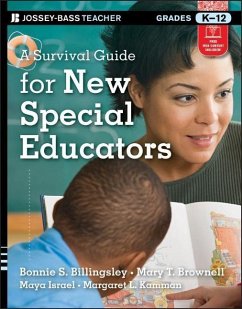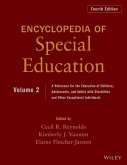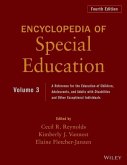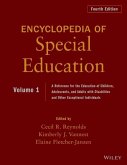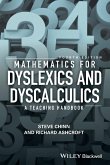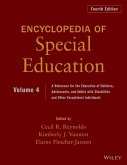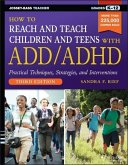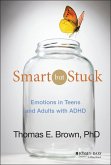Bonnie S. Billingsley, Mary T. Brownell, Maya Israel, Margaret L. Kamman
A Survival Guide for New Special Educators
Bonnie S. Billingsley, Mary T. Brownell, Maya Israel, Margaret L. Kamman
A Survival Guide for New Special Educators
- Broschiertes Buch
- Merkliste
- Auf die Merkliste
- Bewerten Bewerten
- Teilen
- Produkt teilen
- Produkterinnerung
- Produkterinnerung
What every special education teacher needs to know to survive and thrive
A Survival Guide for New Special Educators provides relevant, practical information for new special education teachers across a broad range of topic areas. Drawing on the latest research on special educator effectiveness and retention, this comprehensive, go-to resource addresses the most pressing needs of novice instructors, resource teachers, and inclusion specialists. Offers research-based, classroom-tested strategies for working with a variety of special needs students Covers everything from preparing for the new…mehr
Andere Kunden interessierten sich auch für
![Encyclopedia of Special Education, Volume 2 Encyclopedia of Special Education, Volume 2]() Encyclopedia of Special Education, Volume 2236,99 €
Encyclopedia of Special Education, Volume 2236,99 €![Encyclopedia of Special Education, Volume 3 Encyclopedia of Special Education, Volume 3]() Encyclopedia of Special Education, Volume 3236,99 €
Encyclopedia of Special Education, Volume 3236,99 €![Encyclopedia of Special Education, Volume 1 Encyclopedia of Special Education, Volume 1]() Cecil R. ReynoldsEncyclopedia of Special Education, Volume 1236,99 €
Cecil R. ReynoldsEncyclopedia of Special Education, Volume 1236,99 €![Mathematics for Dyslexics and Dyscalculics Mathematics for Dyslexics and Dyscalculics]() Steve ChinnMathematics for Dyslexics and Dyscalculics51,99 €
Steve ChinnMathematics for Dyslexics and Dyscalculics51,99 €![Encyclopedia of Special Education, Volume 4 Encyclopedia of Special Education, Volume 4]() Encyclopedia of Special Education, Volume 4236,99 €
Encyclopedia of Special Education, Volume 4236,99 €![How to Reach and Teach Children and Teens with ADD/ADHD How to Reach and Teach Children and Teens with ADD/ADHD]() Sandra F. RiefHow to Reach and Teach Children and Teens with ADD/ADHD32,99 €
Sandra F. RiefHow to Reach and Teach Children and Teens with ADD/ADHD32,99 €![Smart But Stuck Smart But Stuck]() Thomas E. BrownSmart But Stuck28,99 €
Thomas E. BrownSmart But Stuck28,99 €-
-
-
What every special education teacher needs to know to survive and thrive
A Survival Guide for New Special Educators provides relevant, practical information for new special education teachers across a broad range of topic areas. Drawing on the latest research on special educator effectiveness and retention, this comprehensive, go-to resource addresses the most pressing needs of novice instructors, resource teachers, and inclusion specialists.
Offers research-based, classroom-tested strategies for working with a variety of special needs students
Covers everything from preparing for the new school year to behavior management, customizing curriculum, creating effective IEPs, and more
Billingsley and Brownell are noted experts in special educator training and support
This highly practical book is filled with checklists, forms, and tools that special educators can use every day to help ensure that all special needs students get the rich, rewarding education they deserve.
Hinweis: Dieser Artikel kann nur an eine deutsche Lieferadresse ausgeliefert werden.
A Survival Guide for New Special Educators provides relevant, practical information for new special education teachers across a broad range of topic areas. Drawing on the latest research on special educator effectiveness and retention, this comprehensive, go-to resource addresses the most pressing needs of novice instructors, resource teachers, and inclusion specialists.
Offers research-based, classroom-tested strategies for working with a variety of special needs students
Covers everything from preparing for the new school year to behavior management, customizing curriculum, creating effective IEPs, and more
Billingsley and Brownell are noted experts in special educator training and support
This highly practical book is filled with checklists, forms, and tools that special educators can use every day to help ensure that all special needs students get the rich, rewarding education they deserve.
Hinweis: Dieser Artikel kann nur an eine deutsche Lieferadresse ausgeliefert werden.
Produktdetails
- Produktdetails
- J-B Ed: Survival Guides .
- Verlag: Wiley & Sons
- 1. Auflage
- Seitenzahl: 432
- Erscheinungstermin: 26. April 2013
- Englisch
- Abmessung: 279mm x 218mm x 22mm
- Gewicht: 840g
- ISBN-13: 9781118095683
- ISBN-10: 1118095685
- Artikelnr.: 36626934
- Herstellerkennzeichnung
- Libri GmbH
- Europaallee 1
- 36244 Bad Hersfeld
- gpsr@libri.de
- J-B Ed: Survival Guides .
- Verlag: Wiley & Sons
- 1. Auflage
- Seitenzahl: 432
- Erscheinungstermin: 26. April 2013
- Englisch
- Abmessung: 279mm x 218mm x 22mm
- Gewicht: 840g
- ISBN-13: 9781118095683
- ISBN-10: 1118095685
- Artikelnr.: 36626934
- Herstellerkennzeichnung
- Libri GmbH
- Europaallee 1
- 36244 Bad Hersfeld
- gpsr@libri.de
BONNIE S. BILLINGSLEY, Ed.D., is a professor in Teaching and Learning at Virginia Tech. MARY T. BROWNELL, Ph.D., is a professor of Special Education and director of the CEEDAR Center at the University of Florida. MAYA ISRAEL, Ph.D., is assistant professor of Special Education at the University of Illinois, Urbana-Champaign. MARGARET L. KAMMAN, Ph.D., is assistant scholar and project coordinator for the CEEDAR Center at the University of Florida.
The Authors v
Acknowledgments vii
Tables, Figures, and Exhibits xvii
Introduction xxi
Part One: The Basics
Chapter One: Getting the Right Job 3
An Initial Priority: Find a Good Job Match 3
Steps in Your Job Search 4
The Interview Process 5
Consider the Offer 10
To Sum Up 10
What's Next? 10
Chapter Two: Great Beginnings 11
Reality 101: What to Expect in the First Years 11
Your Challenge: Become an Accomplished and Committed Special Educator 13
Reflect on the Moral Purpose That Guides Your Work 13
Develop Knowledge about Professional Standards and Ethics 14
Learn about the Community and Key Policies and Guidelines 15
Learn More about the Content Standards for Subjects You Teach 16
Use and Refine Your Knowledge about Evidence-Based Practices 17
Know Your Students and Systematically Monitor Their Learning 17
Collaborate Effectively with Administrators, Colleagues, and Parents 18
Protect Instructional Time and Balance Your Responsibilities 18
Develop Resilience and Manage Stress 18
Take Initiative for Your Own Professional Learning 20
Making It Happen: Create a Network of Supports 20
To Sum Up 25
What's Next? 25
Additional Resources 25
Chapter Three: Working with Others 26
Be an Energizer 27
Be an Effective Communicator 27
Working Through Conflicts 30
A Great Start with Parents 31
Ten Actions to Develop Positive Relationships with Parents 32
A Great Start with Administrators 35
A Great Start with Your Mentor(s) 38
A Great Start with Colleagues 42
Leading Effective Professional Meetings 44
To Sum Up 46
What's Next? 46
Additional Resources 46
Chapter Four: Special Education Law 47
Key Laws Related to Students with Disabilities 47
Education for All Handicapped Children Act 48
Individuals with Disabilities Education Act 51
Section 504 56
Americans with Disabilities Act 57
Confidentiality 58
Dealing with Legal Challenges 61
To Sum Up 63
What's Next? 63
Additional Resources 63
Chapter Five: Developing Quality IEPs 65
The IEP Document 66
The IEP Process 66
Tips for a Great Start with IEPs 66
Tips for Developing IEP Components 67
The IEP Meeting 74
Transition Planning 81
IEP Summary Forms 83
Tips for Organizing the IEP Process 83
Practical Suggestions from Special Educators 85
To Sum Up 85
What's Next? 86
Additional Resources 86
Part Two: Becoming An Accomplished Educator
Chapter Six: Organizing and Managing Your Work 89
Your Many Roles and Responsibilities 90
Goals and Plans Equal Organizational Success! 92
Manage Your Time, Manage Your Tasks 96
Setting Up Your Class for Success 97
Considerations for Middle and High School Classrooms 98
The Teacher's Desk 102
Get Ready for Your First Day of School 104
Plan for Fun and Knowledge 105
To Sum Up 110
What's Next? 110
Additional Resources 111
Chapter Seven: Classroom and Behavior Management 112
Elizabeth Bettini
Tiered Approach to Providing Positive Behavioral Support 113
Evaluating the Intervention 136
To Sum Up 137
What's Next? 137
Additional Resources 137
Chapter Eight: Collaboration and Co-Teaching 139
Fundamentals of Collaboration 140
Defining Characteristics for Collaboration 140
Understanding Collaboration in Varied Service-Delivery Models 140
Tips for Special Education Teachers in Collaborating for RTI 142
Collaboration in Inclusive Settings 142
Small Strategies to Make a Big Impact on Collaboration 146
Helping General Educators 147
Co-Teaching 149
The Co-Teacher Relationship 150
Characteristics Aiding in Successful Co-Teaching 154
Barriers and How to Overcome Them 154
Keeping Collaborative Records 155
To Sum Up 156
What's Next? 157
Additional Resources 157
Chapter Nine: Supporting Your Students 158
The Student-Teacher Relationship 159
Tips for Fostering Positive Student-Teacher Relationships 159
Motivating Your Students 161
Advocating for and with Your Students 164
Culturally Responsive Teaching 166
Helping Your Students Stay Organized and Learn Responsibility 169
To Sum Up 171
What's Next? 171
Additional Resources 171
Chapter Ten: Assessment and Knowing Your Students 172
Your State Standards and the CCSS 173
Why Test in Relationship to the Standards? 173
Educational Laws and Assessment 173
Relationship Between the Laws and Your Assessment Practices 174
Progress Monitoring and Curriculum-Based Measures 175
Formal or Standardized Tests 178
Assessment Accommodations and Adapting Classroom Tests 179
Alternative Assessments 181
Feedback and Grading 183
Assessment Considerations at the High School Level 186
To Sum Up 188
What's Next? 189
Additional Resources 189
Chapter Eleven: Universal Design for Learning and Technology 190
Plan Engaging and Accessible Instruction through UDL 192
The Basics of UDL: Reach and Engage Your Students in Multiple Ways 192
Three Principles of UDL: Multiple Means of Representation, Action and
Expression, and Engagement 193
General Hints for Implementing UDL 196
Using Instructional Technologies to Support Students with Disabilities 203
ATs to Support Students with Disabilities 207
To Sum Up 210
What's Next? 210
Additional Resources 210
Part Three: Mastering Effective Practices
Chapter Twelve: Effective Instructional Practices and Lesson Planning 215
Planning for Effective Instruction 216
Using Effective Instruction 223
To Sum Up 232
What's Next? 233
Additional Resources 233
Chapter Thirteen: Teaching Reading 234
A Framework for Teaching Reading 235
Phonological Awareness and Phonics (Basic Decoding) 235
Decoding Multisyllabic Words and Promoting Morphological Awareness 239
Vocabulary Instruction 241
Promoting Fluency at the Rime, Word, and Connected-Text Levels 243
Promoting Reading Comprehension 245
Special Considerations for ELLs with Learning Disabilities 248
Incorporating Technology into Reading Instruction 248
To Sum Up 250
What's Next? 251
Additional Resources 251
Chapter Fourteen: Teaching Writing 252
Basic Skills Underlying Proficient Writing Performance 252
Becoming an Independent Writer 255
Special Considerations for ELLs 261
Using Technology to Support Writing 262
To Sum Up 263
What's Next? 263
Additional Resources 263
Chapter Fifteen: Teaching Mathematics 264
What Makes Math So Difficult for So Many Students? 265
Going Beyond Arithmetic to Algebra 266
Characteristics of Struggling Learners in Mathematics and General
Strategies for Supporting Students 267
Instructional Math Standards 269
How Should I Teach Learners Who Have Difficulty Keeping Up with the
Curriculum? 271
Instruction That Supports Students with Disabilities in Mathematics 271
What Is the Best Way to Integrate CRA into Math Instruction? 274
Metacognitive Math Strategies 277
Assessment and Feedback to Inform Mathematics Practice 278
Formal Assessment and Mathematics 281
Technology-Enhanced Mathematics Instruction 282
To Sum Up 284
What's Next? 284
Additional Resources 284
Chapter Sixteen: Teaching Content 285
What Can You Do to Support Students with Disabilities in Learning Content?
285
What Specific Things Can You Do to Help Students with Disabilities in the
Content Areas? 286
UDL and Instructional Technologies in Content Learning 292
Teaching Concepts with Content Enhancements 293
Teaching Simple Concepts 293
Complex Concepts 294
Inquiry-Based Approaches to Teaching and Learning Content 295
What Is the Relationship Between Inquiry Learning and Problem-, Project-,
and Challenge-Based Learning? 299
To Sum Up 301
What's Next? 301
Additional Resources 301
Chapter Seventeen: Teaching Students with Limited to Pervasive Intellectual
Disability 303
Bree A. Jimenez and Pamela J. Mims
Who Are Your Students? 304
What to Teach 304
Why Teach Beyond Functional Skills to Students with Intellectual
Disabilities 304
Assessments to Guide Curricular Planning 306
How to Teach 308
To Sum Up 321
What's Next? 321
Additional Resources 321
Part Four: Additional Considerations
Chapter Eighteen: Managing Student Health Needs 325
Pamela W. Carter
Individual Health-Care Plans and Emergency Care Plans 326
Health Conditions and Teacher Tips 326
Tourette Syndrome (TS) 341
To Sum Up 343
Additional Resources 343
Part Five: Appendixes
Appendix A: Definitions and Resources about Disability 345
Attention Deficit Hyperactivity Disorder (ADHD) 347
Autism Spectrum Disorders 350
Deafness and Hearing Loss 353
Developmental Delay 355
Emotional Disturbance 356
Intellectual Disability 361
Other Health Impairment 362
Specific Learning Disability 365
Speech and Language Disorders 367
Traumatic Brain Injury 369
Visual Impairment Including Blindness 371
Appendix B: Key Special Education Cases 373
Appendix C: Assessment Vocabulary and Concepts 374
Validity and Reliability 375
Appendix D: Tips for Preparing for Observations and Evaluations 377
Appendix E: Bonus Web Content 380
Notes 383
Index 400
Acknowledgments vii
Tables, Figures, and Exhibits xvii
Introduction xxi
Part One: The Basics
Chapter One: Getting the Right Job 3
An Initial Priority: Find a Good Job Match 3
Steps in Your Job Search 4
The Interview Process 5
Consider the Offer 10
To Sum Up 10
What's Next? 10
Chapter Two: Great Beginnings 11
Reality 101: What to Expect in the First Years 11
Your Challenge: Become an Accomplished and Committed Special Educator 13
Reflect on the Moral Purpose That Guides Your Work 13
Develop Knowledge about Professional Standards and Ethics 14
Learn about the Community and Key Policies and Guidelines 15
Learn More about the Content Standards for Subjects You Teach 16
Use and Refine Your Knowledge about Evidence-Based Practices 17
Know Your Students and Systematically Monitor Their Learning 17
Collaborate Effectively with Administrators, Colleagues, and Parents 18
Protect Instructional Time and Balance Your Responsibilities 18
Develop Resilience and Manage Stress 18
Take Initiative for Your Own Professional Learning 20
Making It Happen: Create a Network of Supports 20
To Sum Up 25
What's Next? 25
Additional Resources 25
Chapter Three: Working with Others 26
Be an Energizer 27
Be an Effective Communicator 27
Working Through Conflicts 30
A Great Start with Parents 31
Ten Actions to Develop Positive Relationships with Parents 32
A Great Start with Administrators 35
A Great Start with Your Mentor(s) 38
A Great Start with Colleagues 42
Leading Effective Professional Meetings 44
To Sum Up 46
What's Next? 46
Additional Resources 46
Chapter Four: Special Education Law 47
Key Laws Related to Students with Disabilities 47
Education for All Handicapped Children Act 48
Individuals with Disabilities Education Act 51
Section 504 56
Americans with Disabilities Act 57
Confidentiality 58
Dealing with Legal Challenges 61
To Sum Up 63
What's Next? 63
Additional Resources 63
Chapter Five: Developing Quality IEPs 65
The IEP Document 66
The IEP Process 66
Tips for a Great Start with IEPs 66
Tips for Developing IEP Components 67
The IEP Meeting 74
Transition Planning 81
IEP Summary Forms 83
Tips for Organizing the IEP Process 83
Practical Suggestions from Special Educators 85
To Sum Up 85
What's Next? 86
Additional Resources 86
Part Two: Becoming An Accomplished Educator
Chapter Six: Organizing and Managing Your Work 89
Your Many Roles and Responsibilities 90
Goals and Plans Equal Organizational Success! 92
Manage Your Time, Manage Your Tasks 96
Setting Up Your Class for Success 97
Considerations for Middle and High School Classrooms 98
The Teacher's Desk 102
Get Ready for Your First Day of School 104
Plan for Fun and Knowledge 105
To Sum Up 110
What's Next? 110
Additional Resources 111
Chapter Seven: Classroom and Behavior Management 112
Elizabeth Bettini
Tiered Approach to Providing Positive Behavioral Support 113
Evaluating the Intervention 136
To Sum Up 137
What's Next? 137
Additional Resources 137
Chapter Eight: Collaboration and Co-Teaching 139
Fundamentals of Collaboration 140
Defining Characteristics for Collaboration 140
Understanding Collaboration in Varied Service-Delivery Models 140
Tips for Special Education Teachers in Collaborating for RTI 142
Collaboration in Inclusive Settings 142
Small Strategies to Make a Big Impact on Collaboration 146
Helping General Educators 147
Co-Teaching 149
The Co-Teacher Relationship 150
Characteristics Aiding in Successful Co-Teaching 154
Barriers and How to Overcome Them 154
Keeping Collaborative Records 155
To Sum Up 156
What's Next? 157
Additional Resources 157
Chapter Nine: Supporting Your Students 158
The Student-Teacher Relationship 159
Tips for Fostering Positive Student-Teacher Relationships 159
Motivating Your Students 161
Advocating for and with Your Students 164
Culturally Responsive Teaching 166
Helping Your Students Stay Organized and Learn Responsibility 169
To Sum Up 171
What's Next? 171
Additional Resources 171
Chapter Ten: Assessment and Knowing Your Students 172
Your State Standards and the CCSS 173
Why Test in Relationship to the Standards? 173
Educational Laws and Assessment 173
Relationship Between the Laws and Your Assessment Practices 174
Progress Monitoring and Curriculum-Based Measures 175
Formal or Standardized Tests 178
Assessment Accommodations and Adapting Classroom Tests 179
Alternative Assessments 181
Feedback and Grading 183
Assessment Considerations at the High School Level 186
To Sum Up 188
What's Next? 189
Additional Resources 189
Chapter Eleven: Universal Design for Learning and Technology 190
Plan Engaging and Accessible Instruction through UDL 192
The Basics of UDL: Reach and Engage Your Students in Multiple Ways 192
Three Principles of UDL: Multiple Means of Representation, Action and
Expression, and Engagement 193
General Hints for Implementing UDL 196
Using Instructional Technologies to Support Students with Disabilities 203
ATs to Support Students with Disabilities 207
To Sum Up 210
What's Next? 210
Additional Resources 210
Part Three: Mastering Effective Practices
Chapter Twelve: Effective Instructional Practices and Lesson Planning 215
Planning for Effective Instruction 216
Using Effective Instruction 223
To Sum Up 232
What's Next? 233
Additional Resources 233
Chapter Thirteen: Teaching Reading 234
A Framework for Teaching Reading 235
Phonological Awareness and Phonics (Basic Decoding) 235
Decoding Multisyllabic Words and Promoting Morphological Awareness 239
Vocabulary Instruction 241
Promoting Fluency at the Rime, Word, and Connected-Text Levels 243
Promoting Reading Comprehension 245
Special Considerations for ELLs with Learning Disabilities 248
Incorporating Technology into Reading Instruction 248
To Sum Up 250
What's Next? 251
Additional Resources 251
Chapter Fourteen: Teaching Writing 252
Basic Skills Underlying Proficient Writing Performance 252
Becoming an Independent Writer 255
Special Considerations for ELLs 261
Using Technology to Support Writing 262
To Sum Up 263
What's Next? 263
Additional Resources 263
Chapter Fifteen: Teaching Mathematics 264
What Makes Math So Difficult for So Many Students? 265
Going Beyond Arithmetic to Algebra 266
Characteristics of Struggling Learners in Mathematics and General
Strategies for Supporting Students 267
Instructional Math Standards 269
How Should I Teach Learners Who Have Difficulty Keeping Up with the
Curriculum? 271
Instruction That Supports Students with Disabilities in Mathematics 271
What Is the Best Way to Integrate CRA into Math Instruction? 274
Metacognitive Math Strategies 277
Assessment and Feedback to Inform Mathematics Practice 278
Formal Assessment and Mathematics 281
Technology-Enhanced Mathematics Instruction 282
To Sum Up 284
What's Next? 284
Additional Resources 284
Chapter Sixteen: Teaching Content 285
What Can You Do to Support Students with Disabilities in Learning Content?
285
What Specific Things Can You Do to Help Students with Disabilities in the
Content Areas? 286
UDL and Instructional Technologies in Content Learning 292
Teaching Concepts with Content Enhancements 293
Teaching Simple Concepts 293
Complex Concepts 294
Inquiry-Based Approaches to Teaching and Learning Content 295
What Is the Relationship Between Inquiry Learning and Problem-, Project-,
and Challenge-Based Learning? 299
To Sum Up 301
What's Next? 301
Additional Resources 301
Chapter Seventeen: Teaching Students with Limited to Pervasive Intellectual
Disability 303
Bree A. Jimenez and Pamela J. Mims
Who Are Your Students? 304
What to Teach 304
Why Teach Beyond Functional Skills to Students with Intellectual
Disabilities 304
Assessments to Guide Curricular Planning 306
How to Teach 308
To Sum Up 321
What's Next? 321
Additional Resources 321
Part Four: Additional Considerations
Chapter Eighteen: Managing Student Health Needs 325
Pamela W. Carter
Individual Health-Care Plans and Emergency Care Plans 326
Health Conditions and Teacher Tips 326
Tourette Syndrome (TS) 341
To Sum Up 343
Additional Resources 343
Part Five: Appendixes
Appendix A: Definitions and Resources about Disability 345
Attention Deficit Hyperactivity Disorder (ADHD) 347
Autism Spectrum Disorders 350
Deafness and Hearing Loss 353
Developmental Delay 355
Emotional Disturbance 356
Intellectual Disability 361
Other Health Impairment 362
Specific Learning Disability 365
Speech and Language Disorders 367
Traumatic Brain Injury 369
Visual Impairment Including Blindness 371
Appendix B: Key Special Education Cases 373
Appendix C: Assessment Vocabulary and Concepts 374
Validity and Reliability 375
Appendix D: Tips for Preparing for Observations and Evaluations 377
Appendix E: Bonus Web Content 380
Notes 383
Index 400
The Authors v
Acknowledgments vii
Tables, Figures, and Exhibits xvii
Introduction xxi
Part One: The Basics
Chapter One: Getting the Right Job 3
An Initial Priority: Find a Good Job Match 3
Steps in Your Job Search 4
The Interview Process 5
Consider the Offer 10
To Sum Up 10
What's Next? 10
Chapter Two: Great Beginnings 11
Reality 101: What to Expect in the First Years 11
Your Challenge: Become an Accomplished and Committed Special Educator 13
Reflect on the Moral Purpose That Guides Your Work 13
Develop Knowledge about Professional Standards and Ethics 14
Learn about the Community and Key Policies and Guidelines 15
Learn More about the Content Standards for Subjects You Teach 16
Use and Refine Your Knowledge about Evidence-Based Practices 17
Know Your Students and Systematically Monitor Their Learning 17
Collaborate Effectively with Administrators, Colleagues, and Parents 18
Protect Instructional Time and Balance Your Responsibilities 18
Develop Resilience and Manage Stress 18
Take Initiative for Your Own Professional Learning 20
Making It Happen: Create a Network of Supports 20
To Sum Up 25
What's Next? 25
Additional Resources 25
Chapter Three: Working with Others 26
Be an Energizer 27
Be an Effective Communicator 27
Working Through Conflicts 30
A Great Start with Parents 31
Ten Actions to Develop Positive Relationships with Parents 32
A Great Start with Administrators 35
A Great Start with Your Mentor(s) 38
A Great Start with Colleagues 42
Leading Effective Professional Meetings 44
To Sum Up 46
What's Next? 46
Additional Resources 46
Chapter Four: Special Education Law 47
Key Laws Related to Students with Disabilities 47
Education for All Handicapped Children Act 48
Individuals with Disabilities Education Act 51
Section 504 56
Americans with Disabilities Act 57
Confidentiality 58
Dealing with Legal Challenges 61
To Sum Up 63
What's Next? 63
Additional Resources 63
Chapter Five: Developing Quality IEPs 65
The IEP Document 66
The IEP Process 66
Tips for a Great Start with IEPs 66
Tips for Developing IEP Components 67
The IEP Meeting 74
Transition Planning 81
IEP Summary Forms 83
Tips for Organizing the IEP Process 83
Practical Suggestions from Special Educators 85
To Sum Up 85
What's Next? 86
Additional Resources 86
Part Two: Becoming An Accomplished Educator
Chapter Six: Organizing and Managing Your Work 89
Your Many Roles and Responsibilities 90
Goals and Plans Equal Organizational Success! 92
Manage Your Time, Manage Your Tasks 96
Setting Up Your Class for Success 97
Considerations for Middle and High School Classrooms 98
The Teacher's Desk 102
Get Ready for Your First Day of School 104
Plan for Fun and Knowledge 105
To Sum Up 110
What's Next? 110
Additional Resources 111
Chapter Seven: Classroom and Behavior Management 112
Elizabeth Bettini
Tiered Approach to Providing Positive Behavioral Support 113
Evaluating the Intervention 136
To Sum Up 137
What's Next? 137
Additional Resources 137
Chapter Eight: Collaboration and Co-Teaching 139
Fundamentals of Collaboration 140
Defining Characteristics for Collaboration 140
Understanding Collaboration in Varied Service-Delivery Models 140
Tips for Special Education Teachers in Collaborating for RTI 142
Collaboration in Inclusive Settings 142
Small Strategies to Make a Big Impact on Collaboration 146
Helping General Educators 147
Co-Teaching 149
The Co-Teacher Relationship 150
Characteristics Aiding in Successful Co-Teaching 154
Barriers and How to Overcome Them 154
Keeping Collaborative Records 155
To Sum Up 156
What's Next? 157
Additional Resources 157
Chapter Nine: Supporting Your Students 158
The Student-Teacher Relationship 159
Tips for Fostering Positive Student-Teacher Relationships 159
Motivating Your Students 161
Advocating for and with Your Students 164
Culturally Responsive Teaching 166
Helping Your Students Stay Organized and Learn Responsibility 169
To Sum Up 171
What's Next? 171
Additional Resources 171
Chapter Ten: Assessment and Knowing Your Students 172
Your State Standards and the CCSS 173
Why Test in Relationship to the Standards? 173
Educational Laws and Assessment 173
Relationship Between the Laws and Your Assessment Practices 174
Progress Monitoring and Curriculum-Based Measures 175
Formal or Standardized Tests 178
Assessment Accommodations and Adapting Classroom Tests 179
Alternative Assessments 181
Feedback and Grading 183
Assessment Considerations at the High School Level 186
To Sum Up 188
What's Next? 189
Additional Resources 189
Chapter Eleven: Universal Design for Learning and Technology 190
Plan Engaging and Accessible Instruction through UDL 192
The Basics of UDL: Reach and Engage Your Students in Multiple Ways 192
Three Principles of UDL: Multiple Means of Representation, Action and
Expression, and Engagement 193
General Hints for Implementing UDL 196
Using Instructional Technologies to Support Students with Disabilities 203
ATs to Support Students with Disabilities 207
To Sum Up 210
What's Next? 210
Additional Resources 210
Part Three: Mastering Effective Practices
Chapter Twelve: Effective Instructional Practices and Lesson Planning 215
Planning for Effective Instruction 216
Using Effective Instruction 223
To Sum Up 232
What's Next? 233
Additional Resources 233
Chapter Thirteen: Teaching Reading 234
A Framework for Teaching Reading 235
Phonological Awareness and Phonics (Basic Decoding) 235
Decoding Multisyllabic Words and Promoting Morphological Awareness 239
Vocabulary Instruction 241
Promoting Fluency at the Rime, Word, and Connected-Text Levels 243
Promoting Reading Comprehension 245
Special Considerations for ELLs with Learning Disabilities 248
Incorporating Technology into Reading Instruction 248
To Sum Up 250
What's Next? 251
Additional Resources 251
Chapter Fourteen: Teaching Writing 252
Basic Skills Underlying Proficient Writing Performance 252
Becoming an Independent Writer 255
Special Considerations for ELLs 261
Using Technology to Support Writing 262
To Sum Up 263
What's Next? 263
Additional Resources 263
Chapter Fifteen: Teaching Mathematics 264
What Makes Math So Difficult for So Many Students? 265
Going Beyond Arithmetic to Algebra 266
Characteristics of Struggling Learners in Mathematics and General
Strategies for Supporting Students 267
Instructional Math Standards 269
How Should I Teach Learners Who Have Difficulty Keeping Up with the
Curriculum? 271
Instruction That Supports Students with Disabilities in Mathematics 271
What Is the Best Way to Integrate CRA into Math Instruction? 274
Metacognitive Math Strategies 277
Assessment and Feedback to Inform Mathematics Practice 278
Formal Assessment and Mathematics 281
Technology-Enhanced Mathematics Instruction 282
To Sum Up 284
What's Next? 284
Additional Resources 284
Chapter Sixteen: Teaching Content 285
What Can You Do to Support Students with Disabilities in Learning Content?
285
What Specific Things Can You Do to Help Students with Disabilities in the
Content Areas? 286
UDL and Instructional Technologies in Content Learning 292
Teaching Concepts with Content Enhancements 293
Teaching Simple Concepts 293
Complex Concepts 294
Inquiry-Based Approaches to Teaching and Learning Content 295
What Is the Relationship Between Inquiry Learning and Problem-, Project-,
and Challenge-Based Learning? 299
To Sum Up 301
What's Next? 301
Additional Resources 301
Chapter Seventeen: Teaching Students with Limited to Pervasive Intellectual
Disability 303
Bree A. Jimenez and Pamela J. Mims
Who Are Your Students? 304
What to Teach 304
Why Teach Beyond Functional Skills to Students with Intellectual
Disabilities 304
Assessments to Guide Curricular Planning 306
How to Teach 308
To Sum Up 321
What's Next? 321
Additional Resources 321
Part Four: Additional Considerations
Chapter Eighteen: Managing Student Health Needs 325
Pamela W. Carter
Individual Health-Care Plans and Emergency Care Plans 326
Health Conditions and Teacher Tips 326
Tourette Syndrome (TS) 341
To Sum Up 343
Additional Resources 343
Part Five: Appendixes
Appendix A: Definitions and Resources about Disability 345
Attention Deficit Hyperactivity Disorder (ADHD) 347
Autism Spectrum Disorders 350
Deafness and Hearing Loss 353
Developmental Delay 355
Emotional Disturbance 356
Intellectual Disability 361
Other Health Impairment 362
Specific Learning Disability 365
Speech and Language Disorders 367
Traumatic Brain Injury 369
Visual Impairment Including Blindness 371
Appendix B: Key Special Education Cases 373
Appendix C: Assessment Vocabulary and Concepts 374
Validity and Reliability 375
Appendix D: Tips for Preparing for Observations and Evaluations 377
Appendix E: Bonus Web Content 380
Notes 383
Index 400
Acknowledgments vii
Tables, Figures, and Exhibits xvii
Introduction xxi
Part One: The Basics
Chapter One: Getting the Right Job 3
An Initial Priority: Find a Good Job Match 3
Steps in Your Job Search 4
The Interview Process 5
Consider the Offer 10
To Sum Up 10
What's Next? 10
Chapter Two: Great Beginnings 11
Reality 101: What to Expect in the First Years 11
Your Challenge: Become an Accomplished and Committed Special Educator 13
Reflect on the Moral Purpose That Guides Your Work 13
Develop Knowledge about Professional Standards and Ethics 14
Learn about the Community and Key Policies and Guidelines 15
Learn More about the Content Standards for Subjects You Teach 16
Use and Refine Your Knowledge about Evidence-Based Practices 17
Know Your Students and Systematically Monitor Their Learning 17
Collaborate Effectively with Administrators, Colleagues, and Parents 18
Protect Instructional Time and Balance Your Responsibilities 18
Develop Resilience and Manage Stress 18
Take Initiative for Your Own Professional Learning 20
Making It Happen: Create a Network of Supports 20
To Sum Up 25
What's Next? 25
Additional Resources 25
Chapter Three: Working with Others 26
Be an Energizer 27
Be an Effective Communicator 27
Working Through Conflicts 30
A Great Start with Parents 31
Ten Actions to Develop Positive Relationships with Parents 32
A Great Start with Administrators 35
A Great Start with Your Mentor(s) 38
A Great Start with Colleagues 42
Leading Effective Professional Meetings 44
To Sum Up 46
What's Next? 46
Additional Resources 46
Chapter Four: Special Education Law 47
Key Laws Related to Students with Disabilities 47
Education for All Handicapped Children Act 48
Individuals with Disabilities Education Act 51
Section 504 56
Americans with Disabilities Act 57
Confidentiality 58
Dealing with Legal Challenges 61
To Sum Up 63
What's Next? 63
Additional Resources 63
Chapter Five: Developing Quality IEPs 65
The IEP Document 66
The IEP Process 66
Tips for a Great Start with IEPs 66
Tips for Developing IEP Components 67
The IEP Meeting 74
Transition Planning 81
IEP Summary Forms 83
Tips for Organizing the IEP Process 83
Practical Suggestions from Special Educators 85
To Sum Up 85
What's Next? 86
Additional Resources 86
Part Two: Becoming An Accomplished Educator
Chapter Six: Organizing and Managing Your Work 89
Your Many Roles and Responsibilities 90
Goals and Plans Equal Organizational Success! 92
Manage Your Time, Manage Your Tasks 96
Setting Up Your Class for Success 97
Considerations for Middle and High School Classrooms 98
The Teacher's Desk 102
Get Ready for Your First Day of School 104
Plan for Fun and Knowledge 105
To Sum Up 110
What's Next? 110
Additional Resources 111
Chapter Seven: Classroom and Behavior Management 112
Elizabeth Bettini
Tiered Approach to Providing Positive Behavioral Support 113
Evaluating the Intervention 136
To Sum Up 137
What's Next? 137
Additional Resources 137
Chapter Eight: Collaboration and Co-Teaching 139
Fundamentals of Collaboration 140
Defining Characteristics for Collaboration 140
Understanding Collaboration in Varied Service-Delivery Models 140
Tips for Special Education Teachers in Collaborating for RTI 142
Collaboration in Inclusive Settings 142
Small Strategies to Make a Big Impact on Collaboration 146
Helping General Educators 147
Co-Teaching 149
The Co-Teacher Relationship 150
Characteristics Aiding in Successful Co-Teaching 154
Barriers and How to Overcome Them 154
Keeping Collaborative Records 155
To Sum Up 156
What's Next? 157
Additional Resources 157
Chapter Nine: Supporting Your Students 158
The Student-Teacher Relationship 159
Tips for Fostering Positive Student-Teacher Relationships 159
Motivating Your Students 161
Advocating for and with Your Students 164
Culturally Responsive Teaching 166
Helping Your Students Stay Organized and Learn Responsibility 169
To Sum Up 171
What's Next? 171
Additional Resources 171
Chapter Ten: Assessment and Knowing Your Students 172
Your State Standards and the CCSS 173
Why Test in Relationship to the Standards? 173
Educational Laws and Assessment 173
Relationship Between the Laws and Your Assessment Practices 174
Progress Monitoring and Curriculum-Based Measures 175
Formal or Standardized Tests 178
Assessment Accommodations and Adapting Classroom Tests 179
Alternative Assessments 181
Feedback and Grading 183
Assessment Considerations at the High School Level 186
To Sum Up 188
What's Next? 189
Additional Resources 189
Chapter Eleven: Universal Design for Learning and Technology 190
Plan Engaging and Accessible Instruction through UDL 192
The Basics of UDL: Reach and Engage Your Students in Multiple Ways 192
Three Principles of UDL: Multiple Means of Representation, Action and
Expression, and Engagement 193
General Hints for Implementing UDL 196
Using Instructional Technologies to Support Students with Disabilities 203
ATs to Support Students with Disabilities 207
To Sum Up 210
What's Next? 210
Additional Resources 210
Part Three: Mastering Effective Practices
Chapter Twelve: Effective Instructional Practices and Lesson Planning 215
Planning for Effective Instruction 216
Using Effective Instruction 223
To Sum Up 232
What's Next? 233
Additional Resources 233
Chapter Thirteen: Teaching Reading 234
A Framework for Teaching Reading 235
Phonological Awareness and Phonics (Basic Decoding) 235
Decoding Multisyllabic Words and Promoting Morphological Awareness 239
Vocabulary Instruction 241
Promoting Fluency at the Rime, Word, and Connected-Text Levels 243
Promoting Reading Comprehension 245
Special Considerations for ELLs with Learning Disabilities 248
Incorporating Technology into Reading Instruction 248
To Sum Up 250
What's Next? 251
Additional Resources 251
Chapter Fourteen: Teaching Writing 252
Basic Skills Underlying Proficient Writing Performance 252
Becoming an Independent Writer 255
Special Considerations for ELLs 261
Using Technology to Support Writing 262
To Sum Up 263
What's Next? 263
Additional Resources 263
Chapter Fifteen: Teaching Mathematics 264
What Makes Math So Difficult for So Many Students? 265
Going Beyond Arithmetic to Algebra 266
Characteristics of Struggling Learners in Mathematics and General
Strategies for Supporting Students 267
Instructional Math Standards 269
How Should I Teach Learners Who Have Difficulty Keeping Up with the
Curriculum? 271
Instruction That Supports Students with Disabilities in Mathematics 271
What Is the Best Way to Integrate CRA into Math Instruction? 274
Metacognitive Math Strategies 277
Assessment and Feedback to Inform Mathematics Practice 278
Formal Assessment and Mathematics 281
Technology-Enhanced Mathematics Instruction 282
To Sum Up 284
What's Next? 284
Additional Resources 284
Chapter Sixteen: Teaching Content 285
What Can You Do to Support Students with Disabilities in Learning Content?
285
What Specific Things Can You Do to Help Students with Disabilities in the
Content Areas? 286
UDL and Instructional Technologies in Content Learning 292
Teaching Concepts with Content Enhancements 293
Teaching Simple Concepts 293
Complex Concepts 294
Inquiry-Based Approaches to Teaching and Learning Content 295
What Is the Relationship Between Inquiry Learning and Problem-, Project-,
and Challenge-Based Learning? 299
To Sum Up 301
What's Next? 301
Additional Resources 301
Chapter Seventeen: Teaching Students with Limited to Pervasive Intellectual
Disability 303
Bree A. Jimenez and Pamela J. Mims
Who Are Your Students? 304
What to Teach 304
Why Teach Beyond Functional Skills to Students with Intellectual
Disabilities 304
Assessments to Guide Curricular Planning 306
How to Teach 308
To Sum Up 321
What's Next? 321
Additional Resources 321
Part Four: Additional Considerations
Chapter Eighteen: Managing Student Health Needs 325
Pamela W. Carter
Individual Health-Care Plans and Emergency Care Plans 326
Health Conditions and Teacher Tips 326
Tourette Syndrome (TS) 341
To Sum Up 343
Additional Resources 343
Part Five: Appendixes
Appendix A: Definitions and Resources about Disability 345
Attention Deficit Hyperactivity Disorder (ADHD) 347
Autism Spectrum Disorders 350
Deafness and Hearing Loss 353
Developmental Delay 355
Emotional Disturbance 356
Intellectual Disability 361
Other Health Impairment 362
Specific Learning Disability 365
Speech and Language Disorders 367
Traumatic Brain Injury 369
Visual Impairment Including Blindness 371
Appendix B: Key Special Education Cases 373
Appendix C: Assessment Vocabulary and Concepts 374
Validity and Reliability 375
Appendix D: Tips for Preparing for Observations and Evaluations 377
Appendix E: Bonus Web Content 380
Notes 383
Index 400

